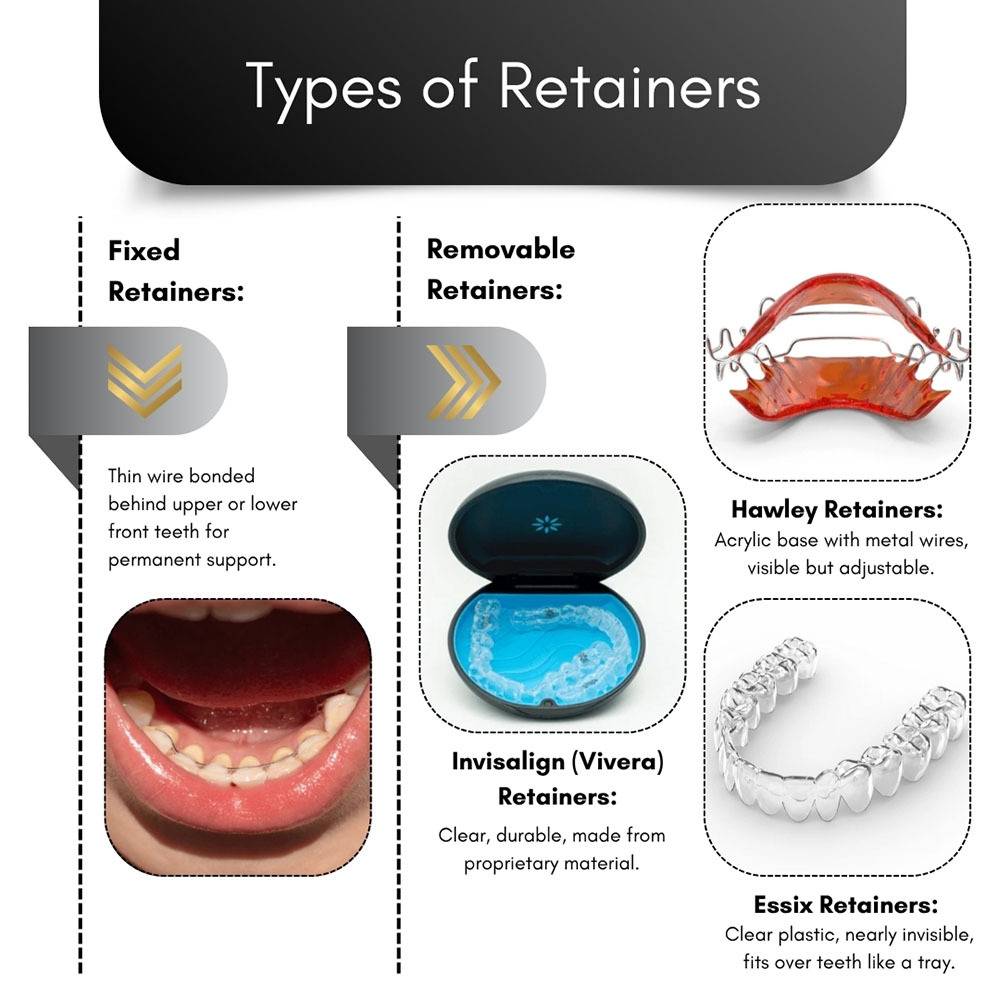What Is a Retainer?
A retainer is an orthodontic device that will keep your teeth in their proper places and the correct alignment for years to come, provided you wear it as recommended. It is custom-made to fit your teeth precisely, helping retain them in their new positions.
Why Do I Need a Retainer?
During orthodontic treatment, your teeth shift into new positions, including your tooth roots. For your teeth roots to move, they need to move through the jawbone surrounding them, so after you finish wearing braces for teeth or aligners, these tooth roots are held less securely in place.
It takes time for the bone to remodel again around your tooth roots. Until new bone growth occurs, there is a risk that your teeth will simply shift back to their previous locations. Even biting and chewing food could cause unwanted tooth movements. Your gums and facial muscles must also get used to the new tooth positions.
While braces straighten your teeth, retainers will retain them in their proper places, preventing them from moving back to their previous locations.
Patient Experience
Are There Different Types of Retainers?
There are two types of retainers as they can be fixed, so they are bonded onto your teeth or removable so you can take them out.
You may only need one type of retainer that could be fixed or removable. However, in certain circumstances, Brooklyn Invisalign Center may recommend using both to help keep your teeth straight.

What Are Fixed Retainers?
Fixed retainers are also called permanent retainers. We fit these retainers onto your teeth after the completion of orthodontic treatment. They generally consist of a thin wire that is bonded onto your teeth.
A fixed retainer can be used on the front upper or lower teeth to prevent them from shifting position over time.
What Are Removable Retainers?
Removable retainers can be taken out and replaced in your mouth as needed. There are two main types available. The most traditional is a Hawley retainer, while another popular type is an Essix retainer. There are also Invisalign retainers.
What Is a Hawley Retainer?
A Hawley retainer has an acrylic base with wires attached that are custom-designed to fit around your teeth. These wires fit across your front teeth, retaining them in place. The retainer is held in place with wires, called Adam’s cribs, that fit around your back teeth.
You can have a Hawley retainer on your upper or lower teeth.
What Is an Essix Retainer?
This removable retainer is made from clear plastic and has no wires. It looks like a clear plastic tooth-whitening tray or a clear aligner. Unlike an aligner tray, it won’t move your teeth; instead, it is custom-designed to hold them in place. An Essix retainer can be fitted over your upper or lower teeth.
Finding a Dentist Offering Retainers Near Me
Need a new retainer or looking to replace a lost one? Whether it’s right after braces or just part of keeping your smile in shape, finding the right place for orthodontic retainers nearby is easier than you might think.
Here’s how to get started:
- Start by searching for “retainers near me,” “dental retainers near me,” or “retainer near me.” These phrases will usually bring up local orthodontists or dentists who offer same-day or custom-made retainer options.
- Use sites like Zocdoc or Google Maps to check office locations, reviews, and availability. You can often see if they offer clear retainers, Hawley retainers, or other types depending on what you need.
- If you’ve had braces recently, contact your orthodontist. They usually keep your mold on file and can quickly make a replacement.
- No longer seeing your old provider? No worries. Many offices that offer orthodontic retainers also accept new patients and can take a fresh impression or digital scan.
- Some practices even offer 3D-printed retainers or nightguards, which might be a good option if you grind your teeth or want something more durable.
- Ask about turnaround time and cost up front. Retainers don’t have to be expensive, and some places offer budget-friendly options or payment plans.
Hawley Retainers vs. Essix Retainers
The main difference between these two retainers is their visibility in the mouth. A Hawley retainer is slightly more visible, thanks to the wire fitting across your front teeth. An Essix retainer is more discreet and trickier to see.
Both are equally effective and reliable. Both are removable and must be taken out for meals. Your choice may be down to your preference, although Essix retainers are extremely popular amongst people who have received Invisalign treatment or have used another clear aligner system.
Invisalign Retainers
Invisalign retainers are basically Essix retainers, except they are made from Invisalign’s proprietary materials and are called Vivera retainers. When you have a retainer after Invisalign, it will look just like an ordinary aligner tray.
How Is a Retainer Fitted?
The process for making a retainer will depend on the type we recommend.
Fixed retainers
A fixed retainer is a metal wire that is bonded onto your teeth. To fit the retainer we must measure the wire and ensure it is closely adapted to fit around your teeth before bonding it in place.
Making and fitting a fixed retainer is a little more intricate since we can do this chairside. However, it does mean you only need one appointment since it doesn’t need to be made in a dental laboratory.
Removable Retainers
There are three steps to making a removable retainer.
- We take a detailed dental impression of your teeth by scanning them. This creates a 3-D digital dental model.
- The digital scan is sent to our dental lab along with your prescription. They will use the digital model to custom-make your retainer.
- It generally takes a week or so to make the retainer, and once it is ready you return to our dental office so we can check its fit and show you how to insert and remove it.
How Long Must I Wear My Retainer?
Initially, you must wear your retainer full-time, usually for at least 4 to 6 months. After this, you can gradually reduce your wearing time, and we will discuss this with you more closely so you know when to begin doing it. However, you will still need to wear your tooth retainer at night, at least part-time, preferably for the rest of your life.
If you have a fixed retainer, this isn’t a problem; the retainer will remain permanently in place until it is removed sometime in the future. The removal date will depend on your circumstances and the degree of teeth straightening originally needed.
What Will Happen if I Don’t Have a Retainer?
If you fail to wear your retainers, your teeth will begin moving. It’s perfectly normal for teeth to shift over time. However, it will mean they become misaligned and crooked, so we recommend occasionally wearing your retainers for life.
Can a Retainer Straighten Teeth?
Your retainer will not straighten your teeth as it isn’t designed to apply constant pressure onto teeth, forcing them to move.
What Happens if I Forget to Wear My Retainers for a While?
If you forget to wear your retainers, you may notice that your teeth have shifted slightly. Wearing your retainer again will help push them back into the proper positions. While this happens, you may feel some minor discomfort, which will only work if you forget to wear your retainer in the short term.
What Happens if My Retainer No Longer Fits?
If you already have a retainer and it has begun to fit less comfortably, it could mean your teeth have shifted. In this case, we might be able to adjust it to fit properly, but it may need to be remade.
Eventually, your retainer will need replacing as it ages, but with the right care, it should last for some time since they are all made from strong, durable materials. Sometimes, retainers can break or crack due to wear and tear. If you notice large cracks or breaks, consult emergency orthodontist promptly to repair or replace your retainers.
When you visit our orthodontic office for teeth straightening, we can discuss retainers with you in more detail since they are an important part of your treatment. We can review the various types available and which would fit best with your lifestyle. If you have any questions or want to book an appointment, call Brooklyn Invisalign Center at (718) 375-3757.

